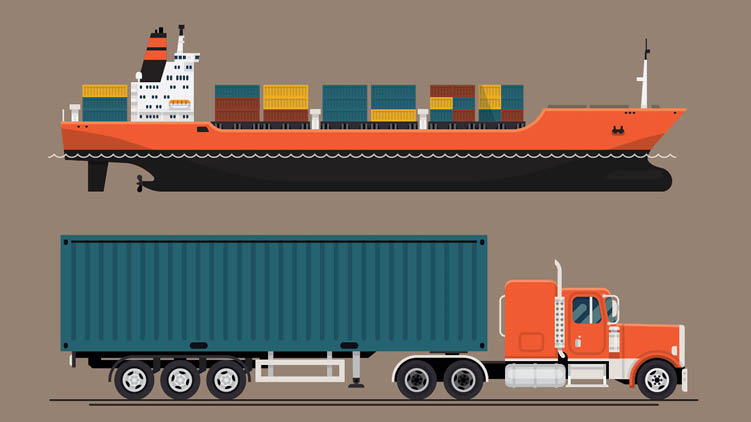
For several decades, the intermodal shipping container has been the global standard for moving goods quickly and efficiently across all distances and, as its name suggests, by different modes of transportation. Containerized goods can range from consumer items, such as clothing and electronics, to agricultural products for wholesalers and intermediate inputs required by manufacturers.
These containers typically range in length from 20 to 53 feet according to international standards and can be moved easily between cargo ships, rail cars and truck trailers. Container capacity is expressed in twenty-foot equivalent units (TEU), a unit of measure equal to one standard 20 by 8 ft (6.10 by 2.44 m) container.

To give an idea of the amount of freight they carry, in 2022, 36.5 million tonnes of freight were moved in Canada by intermodal containers on rail flat cars, up slightly from 2021 (36.4 million). The 39.4 million tonnes moved in 2017 was the highest volume on record since Statistics Canada started tracking these data in 2001 (23.1 million).
Although the overall number of freight cars owned by Canadian mainline companies decreased from 114,334 in 1986 to 54,936 in 2022, the proportion of flat cars increased from about one in five (19.5%) to over one in three (35.7%) over the same period. The 19,633 flat cars on the rails in Canada in 2022 was the largest number recorded since 2006 (20,915).
In May 2024, intermodal shipments (mainly containers) originating in Canada totalled 3.1 million tonnes. This was down from 3.2 million tonnes in April, which was the highest level since August 2022.
Rail transport prices increase, truck transport cheaper
The Freight Rail Services Price Index estimates price changes for the mainline freight rail industry in Canada. In July 2024, the price to move intermodal containers by rail increased 2.5% compared with July 2023.
Similarly, the For-hire Motor Carrier Freight Services Price Index tracks price movements for truck transport. Prices charged by the general freight trucking industry group, which transports a variety of commodities generally palletized and carried in a van trailer, box or container (including intermodal containers), decreased by 3.7% from March 2023 to March 2024.
Price increases slow from two years ago
We last took a look at price movements of various shipping modes in August 2022, when the economy was facing headwinds of supply chain bottlenecks and high inflation, leading to significant increases in transportation costs.
Earlier in 2022, the price of shipping containers themselves had become more expensive, and what used to be a journey of 40-to-50 days in 2019 for a container to get from Asia to North America could have taken up to 110 days in 2022.
Recently released findings from the Survey of Innovation and Business Strategy found that shipping costs, the COVID-19 pandemic and transportation infrastructure barriers were the top three barriers to exporting that were reported as either difficult or very difficult by Canadian exporting businesses in 2022.
While the cost of shipping by container has since plateaued, recent geopolitical conflict in the Middle East has diverted ocean vessels from using the Suez Canal, while weather-related events have reduced the capacity of the Panama Canal. Both situations can result in longer journeys and higher freight rates.
Shorter port dwell times
One indicator of supply chain efficiency is how long it takes for a container to be unloaded off a ship and onto a truck or train at the port.
In December 2023, the average port dwell time for containers was 3.7 days for East Coast ports, up from the previous month (2.2 days) but down from the recent peak of 12.4 days in July 2022.
For West Coast ports, the average dwell time was 4.1 days in December 2023, up from 3.7 days in November 2023. July 2022 and January 2022 each had an average dwell time of 7.3 days.

StatsCAN app
Download the StatsCAN app today to have these articles at your fingertips! Already using the app? Leave a review in the App Store and Google Play and let us know what you think.
Contact information
For more information, contact the Statistical Information Service (toll-free 1-800-263-1136; 514-283-8300; infostats@statcan.gc.ca) or Media Relations (statcan.mediahotline-ligneinfomedias.statcan@statcan.gc.ca).

